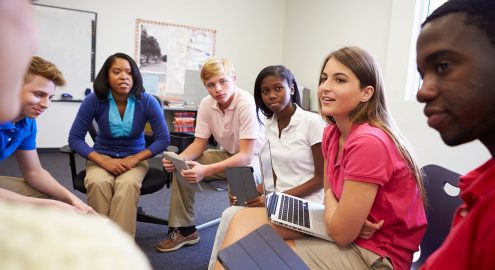What Are They?
Prosocial teaching strategies are not limited to particular curricula or programs, or to certain academic subjects. They are methods and techniques that can be used in a variety of classes, age groups, and circumstances.
What they have in common is that, in addition to serving learning objectives, they promote social-emotional development and prosocial goals. When implemented well, these strategies can aid educators in creating a supportive, caring classroom environment and spur students to behave in kind and helpful ways towards each other.
To help foster cohesive lab groups in the beginning of the school year, a middle school science teacher gives students a contrast experience of working individually versus working in a group. Using straws, plastic wrap, cotton balls, aluminum foil, and paper, each student has one minute to engineer a wall with protective devices so Humpty Dumpty won’t break when he falls. Then, in groups of two, students are instructed to do the task again, but in three minutes. Finally, students are assigned lab roles (project director, materials manager, data recorder, and time keeper) and told to complete the task one last time. After each grouping, the students discuss what worked and what didn’t, with a focus on problem-solving skills, cooperation, and conflict resolution.
Why Are They Important?
Prosocial teaching strategies can create a more positive classroom climate and promote students’ social-emotional development, while also enhancing learning.
Cooperative learning enhances students’ learning and social-emotional development.
- Reviews of the research on cooperative learning show that it has a range of positive effects for students: heightened academic effort and achievement, improved interpersonal relationships, and increased psychological well-being.
- One of the reasons why cooperative learning works so well may be that it promotes empathy.
- Especially when students work together in structured groups—with guidance on how to communicate and collaborate with each other—they not only perform better, but are more helpful towards each other and build stronger group identities.
Strategies that allow students to teach each other benefit both the givers and receivers.
- As stated in a book on teaching and learning by McKeachie and colleagues, “The best answer to the question, ‘What is the most effective method of teaching?’ is that it depends on the goal, the student, the content, and the teacher. But the next best answer is, ‘Students teaching other students.’”
- Research on peer and cross-age tutoring—in math, reading, and in general—shows that both tutors and tutees tend to experience positive results, including improvements in academic performance, attitudes towards school and other students, self-efficacy, and self-concept.
- One study of cross-age tutoring in particular found that the program increased empathy, altruism, and self-esteem in the high school-age tutors.
Supporting student autonomy can also be valuable.
- When combined with peer collaboration and supportive teacher-student relationships, giving elementary school students opportunities for autonomy and decision-making can help foster friendly and prosocial behavior.
- Studies show that a more autonomy-supportive teaching style leads to more engagement and prosocial behavior (and less antisocial behavior).
Practices

Collaboration for Fairness: A Pedagogical Strategy

Contemplating Awe-Inspiring Systems

Sparking Discovery Through Awe

Encouraging Awe and Wonder Through Questioning

An AWE-some Mind-Map Practice

Compass Points

Tug for Truth

3-2-1 Bridge

Respectful Debate

Yes-No-Maybe Current Event Discussion

Norm Co-Creation

Crumpled Reminder

Strategies for Teaching Fearless SEL for Societal Change

Check for Understanding Circle

Self-Assessing Social and Emotional Instruction and Competencies

Four Corners

Carousel Brainstorming

Modeling SEL for Students

Are you ready to build a kinder, happier school where everyone belongs? Join Greater Good Educators! Explore the science of well-being in a supportive community of educators from around the world. Registration is now open for the 2025-2026 school year!


